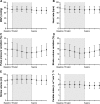Non-invasive measurements of pulse pressure variation and stroke volume variation in anesthetized patients using the Nexfin blood pressure monitor
- PMID: 26318314
- PMCID: PMC5023739
- DOI: 10.1007/s10877-015-9759-7
Non-invasive measurements of pulse pressure variation and stroke volume variation in anesthetized patients using the Nexfin blood pressure monitor
Abstract
Nexfin beat-to-beat arterial blood pressure monitoring enables continuous assessment of hemodynamic indices like cardiac index (CI), pulse pressure variation (PPV) and stroke volume variation (SVV) in the perioperative setting. In this study we investigated whether Nexfin adequately reflects alterations in these hemodynamic parameters during a provoked fluid shift in anesthetized and mechanically ventilated patients. The study included 54 patients undergoing non-thoracic surgery with positive pressure mechanical ventilation. The provoked fluid shift comprised 15° Trendelenburg positioning, and fluid responsiveness was defined as a concomitant increase in stroke volume (SV) >10 %. Nexfin blood pressure measurements were performed during supine steady state, Trendelenburg and supine repositioning. Hemodynamic parameters included arterial blood pressure (MAP), CI, PPV and SVV. Trendelenburg positioning did not affect MAP or CI, but induced a decrease in PPV and SVV by 3.3 ± 2.8 and 3.4 ± 2.7 %, respectively. PPV and SVV returned back to baseline values after repositioning of the patient to baseline. Bland-Altman analysis of SVV and PPV showed a bias of -0.3 ± 3.0 % with limits of agreement ranging from -5.6 to 6.2 %. The SVV was more superior in predicting fluid responsiveness (AUC 0.728) than the PVV (AUC 0.636), respectively. The median bias between PPV and SVV was different for patients younger [-1.5 % (-3 to 0)] or older [+2 % (0-4.75)] than 55 years (P < 0.001), while there were no gender differences in the bias between PPV and SVV. The Nexfin monitor adequately reflects alterations in PPV and SVV during a provoked fluid shift, but the level of agreement between PPV and SVV was low. The SVV tended to be superior over PPV or Eadyn in predicting fluid responsiveness in our population.
Keywords: Anesthesia; Blood pressure; Cardiac output; Fluid challenge; Hemodynamic; Non-invasive monitoring.
Conflict of interest statement
The authors declare that they have no conflict of interest. Ethical approval All procedures performed in studies involving human participants were in accordance with the ethical standards of the institutional and/or national research committee and with the 1964 Helsinki declaration and its later amendments or comparable ethical standards.
Figures




Similar articles
-
[Stroke volume and pulse pressure variation are good predictors of fluid responsiveness in sepsis patients].Acta Med Croatica. 2013 Dec;67(5):407-14. Acta Med Croatica. 2013. PMID: 24979881 Croatian.
-
Stroke volume variation (SVV) and pulse pressure variation (PPV) as indicators of fluid responsiveness in sevoflurane anesthetized mechanically ventilated euvolemic dogs.J Vet Med Sci. 2017 Aug 18;79(8):1437-1445. doi: 10.1292/jvms.16-0287. Epub 2017 Jul 10. J Vet Med Sci. 2017. PMID: 28690287 Free PMC article. Clinical Trial.
-
Noninvasive pulse pressure variation and stroke volume variation to predict fluid responsiveness at multiple thresholds: a prospective observational study.Can J Anaesth. 2015 Nov;62(11):1153-60. doi: 10.1007/s12630-015-0464-2. Epub 2015 Sep 3. Can J Anaesth. 2015. PMID: 26335905 Free PMC article.
-
Fluid Challenge During Anesthesia: A Systematic Review and Meta-analysis.Anesth Analg. 2018 Dec;127(6):1353-1364. doi: 10.1213/ANE.0000000000003834. Anesth Analg. 2018. PMID: 30300177
-
A systematic review of pulse pressure variation and stroke volume variation to predict fluid responsiveness during cardiac and thoracic surgery.J Clin Monit Comput. 2017 Aug;31(4):677-684. doi: 10.1007/s10877-016-9898-5. Epub 2016 Jun 15. J Clin Monit Comput. 2017. PMID: 27306799
Cited by
-
Changes in dynamic arterial elastance induced by volume expansion and vasopressor in the operating room: a prospective bicentre study.Ann Intensive Care. 2019 Oct 11;9(1):117. doi: 10.1186/s13613-019-0588-6. Ann Intensive Care. 2019. PMID: 31602588 Free PMC article.
-
Journal of Clinical Monitoring and Computing 2016 end of year summary: cardiovascular and hemodynamic monitoring.J Clin Monit Comput. 2017 Feb;31(1):5-17. doi: 10.1007/s10877-017-9976-3. Epub 2017 Jan 7. J Clin Monit Comput. 2017. PMID: 28064413 Review.
-
Perioperative hemodynamic optimization: from guidelines to implementation-an experts' opinion paper.Ann Intensive Care. 2021 Apr 14;11(1):58. doi: 10.1186/s13613-021-00845-1. Ann Intensive Care. 2021. PMID: 33852124 Free PMC article. Review.
-
A novel non-invasive blood pressure waveform measuring system compared to Millar applanation tonometry.J Clin Monit Comput. 2018 Aug;32(4):717-727. doi: 10.1007/s10877-017-0070-7. Epub 2017 Oct 4. J Clin Monit Comput. 2018. PMID: 28980101
-
Where Are We Heading With Fluid Responsiveness and Septic Shock?Cureus. 2022 Apr 3;14(4):e23795. doi: 10.7759/cureus.23795. eCollection 2022 Apr. Cureus. 2022. PMID: 35518529 Free PMC article. Review.
References
-
- Cecconi M, Monti G, Hamilton MA, et al. Efficacy of functional hemodynamic parameters in predicting fluid responsiveness with pulse power analysis in surgical patients. Minerva Anestesiol. 2012;78:527–533. - PubMed
Publication types
MeSH terms
LinkOut - more resources
Full Text Sources
Other Literature Sources
Medical

